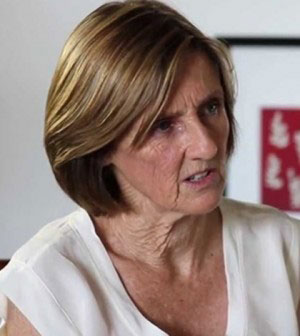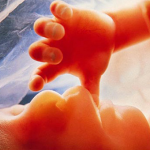White pearls and white clothing, a genteel face softly made up, a thoughtful expression and fashionably controlled hair were the images chosen to promote prenatal testing for “Down Syndrome and other Chromosomal Abnormalities” to pregnant mothers in 2000. Representations of respectability and good order, maturity and beauty with a hint of purity adorn the promotional pamphlet. The desirability and acceptability of combining prenatal screening programmes with antenatal care would seem beyond doubt in a well-ordered society, since they are investigations purchased by the socially responsible and respectable gentlefolk. Advertisers know well how to wrap merchandise. No untoward displays of colour here, certainly no tattoos, no nose piercings – nothing unseemly disturbs the suitability of what this pamphlet is proposing to mothers and yet, the murkiest tattoo, the ugliest nose ring would be less distorting than what this portrait of motherhood is selling.
The original concept of antenatal care was to enhance the health and wellbeing of mother and child. Down syndrome children were always part of that care, part of their family, their community, their town, their school and their G.P.’s practice. Less often seen now, they rarely glimpse each other. The antenatal care which should have guided each one safely to the loving embrace of his or her mother’s arms has become its assailant, a force honored with the title of ‘best medical practice”, which strives to ensure he or she will never be greeted by kith and kin.
Because advanced maternal age is the chief risk factor for Down syndrome, two generations of older mothers have been offered invasive prenatal testing [penetrating the womb to obtain cells with the baby’s genetic material] to diagnose this and other major incurable chromosomal conditions. The original test, amniocentesis, was offered to mothers over 37 years of age, by which time the chance of their babies having Down syndrome exceeded the odds of the testing procedure itself killing the child. To the pragmatic mind it then became worth the risk. Such logic lurks within the philosophy that the life of a Down syndrome person is not worthy to be lived. So unworthy is it that we accept condemning to death up towards one in every fifty babies just looking for the unworthies.[1]
The aim of this radical testing – as distinct from the principles of antenatal care – was and is to eliminate these trisomy 21 babies and all others found to have major abnormalities along the way. There is no planned benefit to these babies. No remedy or therapy awaits the results of their prenatal testing. Although dignified by the Australian College of Obstetricians’ new recommendation of universal access and enhanced by advertising’s suggestion of betterment it remains a pass or fail test for abortion.
For parents who would not normally consider abortion, a parallel language of care has sprung up around the testing process. We hear the testing regimen justified to ‘relieve parental anxiety’ lest they be carrying a Down syndrome child. So horrendous must this diagnosis be that even the anxiety lest it be so warrants elimination. Procedure- related miscarriage becomes an acceptable side effect. We hear it sanctioned to ‘prepare parents’ for a Down syndrome baby, but who can prepare them for a lifetime grieving the child they consented to an unnecessary procedure? We hear it proposed on the grounds that a Down’s baby may also have a heart defect requiring urgent treatment and delivery in a more appropriate hospital. We don’t hear, however, that this and other scenarios postulated are rarer than the procedure-related fatality rate.
Relieving anxiety and preparing parents sound plausible and even praiseworthy but how many of us would board a jumbo jet knowing that two or three people would randomly be killed on the plane. How many of us would put our children on such a flight? This, however, is the travel package being offered to modern mothers and fathers. In skillfully crafted brochures, in current prenatal diagnostic programmes imperceptibly merged with antenatal care and under the camouflage of compassionate causes, they are being encouraged to commit their children to just such a journey. What deception masquerades through our language as ‘peace of mind’ as we place our children’s lives in jeopardy? What ‘psychological preparation’ is fulfilled by parents consenting and consigning their child to dangerous and unjustifiable testing? Is the eugenic ideology so veiled that even the advocacy of a mother and father cannot penetrate it? Indeed, how much more mental and emotional distress will be suffered by the parents whose babies bear the procedure’s mortality rate and whose little lives are reduced to a mere procedural hazard?
Where are the voices of obstetric care which have not yielded to this slide of “best medical practice” into deadly ideologies? Who is shining a light into these dark recesses? Since 2000, the drive to diagnose more and more babies with major untreatable chromosomal abnormalities in early pregnancy has accelerated in intensity. Knowing that many children with trisomies 21, 13 or 18 were slipping through the net undetected and being born to mothers too young to have mobilized medical suspicion, much energy and effort and an unknowable amount of money have been focused on a prenatal screening programme to locate and issue boarding passes to all those kids with a significant risk of Down syndrome. The Royal Australian and New Zealand College of Obstetricians and Gynaecologists now recommend that all expectant mothers be offered Down Syndrome screening [2] to select out those babies labeled as at ‘significant risk’ of Down’s for the further invasive chromosomal test.
A study published in the Medical .Journal of Australia on 5th March 2007 reported on declining rates of Down syndrome births in the private and urban sector but not in the public or rural sectors, according to Queensland researchers. Immediate indignation followed. A senior lecturer in maternal- foetal medicine at the University of New South Wales likened the findings to a disparity in the quality of cancer care.[3] The Medical Journal of Australia concluded that “recent economic analyses have shown that population-based screening probably represents value for money. When the costs of screening are offset against the life-time costs of caring for a person with Down syndrome, screening is less costly than no screening at all regardless of which screening strategy is used.” It does own that some regard this arithmetic as “distasteful”, but draws its support from the findings of the 2002 Medical Services Advisory Committee which recommended foetal nuchal translucency ultrasound and first trimester serum testing be incorporated into existing early pregnancy services “for screening for trisomy 21 and other autosomal trisomies”. With an overall false positive rate of 5% this screening now detects over 85% of Down syndrome. However, for women in their mid forties – when these particular babies are most avidly pursued – the false positive rate from prenatal screening is set much higher at close to 50 %, to maximize the detection rate so that none slip through. For every 100 pregnant women aged 44 who have the prenatal screening test for Down syndrome, 52 will be told their screening test is positive, but only about 4 to 5 of them will actually have a Down syndrome child. The only way to make the diagnosis is from baby’s own genetic information obtained through prenatal diagnostic procedures. This next step imperils the baby’s life.
The Royal Australian and New Zealand College of Obstetricians and Gynaecologists, in their most recent information brochure (2007) preparing parents for informed consent prior to performing the prenatal diagnostic procedure, cites the increased risk of miscarriage. Their evidence based figures are that miscarriage occurs to one in every 100 to 200 babies after amniocentesis (extracting amniotic fluid) and one in every 50 to100 babies after chorionic villus sampling(extracting cells from part of the placenta). A U.S. study published in late 2006 suggested the death rate was much lower than this, but 5per cent of their study was lost to follow-up, and they did not include deaths after 24 weeks gestation. A spokesperson for the College in Australia responded, saying “the ones you lose [to follow-up] are often the ones who have had a miscarriage and are reluctant to talk to researchers”. Other complications of infection, limb deformity and lung problems may also be caused by the test and not show up in miscarriage figures. If our fifty-two mothers decide to board their children on the next step of this journey through chorionic villus sampling, one of their children may not survive it.
Prenatal diagnosis is becoming available for an increasing number of abnormalities to an increasing number of families. Yet the life and death issues involved both in the testing process and its conclusion are not fully understood in modern society. Parents have been led to become fearful and anxious lest their baby fail the expectations of family, friends and the onlooking community. They are made to feel neglectful or selfish if they do not follow state health department advice to “check the baby’s health before birth”. To have it further suggested that Down syndrome is so horrendous a diagnosis that it is worth exposing any child to the hazards of testing to relieve the concern, or to prepare for it can only aggravate this fear and undermine parents’ confidence. Furthermore, the price of this preparedness, of this need to organize, control suspense and prevent the unexpected will be borne by the child. In the face of such values and amid protocols of ‘best medical practice’ and calls from the College of Obstetricians for a nationwide screening programme for Down syndrome, parents and grandparents need truth and authentic support.
This is not a time for the obstetric conscience to reserve its convictions or retreat into silence. It is certainly not a time to spread false information and create undue anxiety. The L.J Goody Bioethics Centre in Western Australia issued a written defence of prenatal screening in 2004. Their paper contains a major medical error. It states that “it is not unusual that a positive screen will return a negative diagnosis (an N.T.S. false positive), which means that the foetus probably carries a pathology other than D.S.” A child with a false positive nuchal translucency screen will probably be entirely normal – if it survives the diagnostic procedure unscathed.
Christian health care institutions need above all to speak, write and act responsibly regarding these issues. The Code of Ethical Standards for Catholic Health and Aged Care Services is equally misleading when it states that prenatal diagnostic procedures can be accessed to gain information about the health of the mother. In the current usage of these terms, prenatal diagnostic procedures are not performed to gain information about the health of the mother and do not report on the health of the mother. This document fails the reader in omitting to define the terms it uses but more seriously it fails to represent the dangers incurred by all foetuses subjected to ‘consentable’ prenatal diagnostic procedures.
The absence of an effective community or professional forum for debate has created an unchallenged environment for prenatal testing programmes. Festering like a carbuncle within the fabric of antenatal care and in the language of compassion and preparedness as much as in the images of good breeding, prenatal testing needs to be lanced and spilt open. Those addressing the malady of prenatal diagnosis will need to be especially vigilant, consistent and audible to penetrate this sinister growth. Puffed up with economic rationales and pragmatism and clothed in pearls and sophistication, the momentum and mandatory compliance behind what we now know as ‘best medical practice’ has swollen to be larger and more important than the mother and child it once sought to benefit.
 Dr.Deirdre Therese Little, MBBS, DRANZCOG,
Dr.Deirdre Therese Little, MBBS, DRANZCOG,
FACRRM, is the President of the organization
Obstetricians Who Respect the Hippocratic Oath.
She practises in New South Wales
[1] RANZCOG A Guide on Prenatal Diagnostic Procedures. Edition number: 4 16 Ja2007.
[2] Prenatal screening involves an ultrasound determination of the width of an area at the back of baby’s neck – the ‘ nuchal translucency’ measurement – as well as some pregnancy protein measurements from a sample of the mother’s blood. A foetal software programme combines these measurements and other information to estimate the risk of Down syndrome or other major chromosome abnormalities.
[3] Äustralian Doctor, 9 March 2007.









